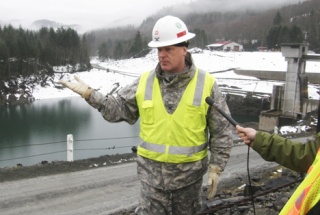The U.S. Army Corps of Engineers built the Howard Hanson Dam on the Green River southeast of Enumclaw nearly 50 years ago to reduce age-old flooding hazards to downstream communities like Auburn, Kent and Tukwila.
And from that day until last January, there were few concerns. The dam kept the waters in check and by so doing, allowed the Green River Valley to develop. Without the dam, the Southcenter area would be a swamp.
Then January’s big storms came and stressed the pool behind the dam with more water than it had ever held. As events unfolded, engineers discovered two sinkholes in the right abutment, a structure made of 10,000-year-old landslide material that supports the right side of the dam.
Engineers have injected dye into the holes to find out what they signify; they have buried sensors in the ground to determine the underlying stability of the abutment. At the moment, however, they still don’t know what the problem is.
Nevertheless, Mark Ohlstrom, chief of engineering and construction for the Corps’ Seattle District, considers the dam safe, and engineers are doing everything they can to keep it that way.
“People need to understand that we don’t feel that the integrity of the structure is in jeopardy,” Ohlstrom told elected officials, emergency planners and media during a tour of the structure last week. “What we do have is an issue that causes us concern that we want to address. We want to make sure that we don’t get to a point of a potential failure of the abutment, which could lead to failure of the dam and catastrophic consequences. We are not there yet, and we want to make sure it doesn’t get there.”
Right now, the Corps is busy with its normal spring refill of the pool, which mainly provides augmentation flows for fish and additional water supplies for the City of Tacoma. During this process, engineers will take extensive measurements to determine what effect filling the pool has on the integrity of the abutment and the dam.
“If we come up with concerns during that point in time, we will make adjustments,” Ohlstrom said.
Engineers hope the studies and some interim actions they are taking will help them learn what they need to this summer.
“We don’t know exactly the problem, so we don’t want to provide the wrong kind of medicine to a dam until we know what its issue is,” said Colonel Anthony Wright, District Corps Commander. “While we don’t know what the right solution is, we are studying various options so that as the data comes in, we won’t have to wait to figure exactly how to apply that solution.”
One key interim solution — bore holes in the abutment and plug them with concrete to stabilize the structure.
Wright said the Corps will not bring the pool to record levels again until the problem is fixed.
Flooding risks loom
And if repairs can’t be effected by the onset of the rainy season in November, downstream communities could be at risk of flooding in the event of a severe storm.
Asked if there was an expectation of a solution this year for the next, Anthony shook his head.
“No, I don’t think that’s a reasonable expectation. I don’t know what the problem is,” he said. “A grout curtain takes a reasonable amount of time to put in, and it takes very specialized equipment in terms of drilling and pumping. We’re not working with an engineered structure, we’re working with a natural landslide. Some of those boulders create some problems.
“I don’t want to give you the expectation that I am going to have a solution in the ground by November that will fix the problem,” he added. “I still believe that this next flood season, the dam is going to be operating with a reduced level of flood risk reduction.”
In addition to completing all necessary technical work, Ohlstrom said engineers will work with elected officials of the various communities and with businesses and residents to provide the best flood reduction risk possible.
The hard part is that no one can say exactly what will happen.
“There have been some reports that coming next fall we are not going to be able to store water,” Ohlstrom said. “At this point, that is not correct. Our intent is to store some water, we just don’t know if we can store all the water we normally would in normal flood control operations.”
Wright offered this bit of parting advice to residents of the Green River Valley: buy flood insurance.



